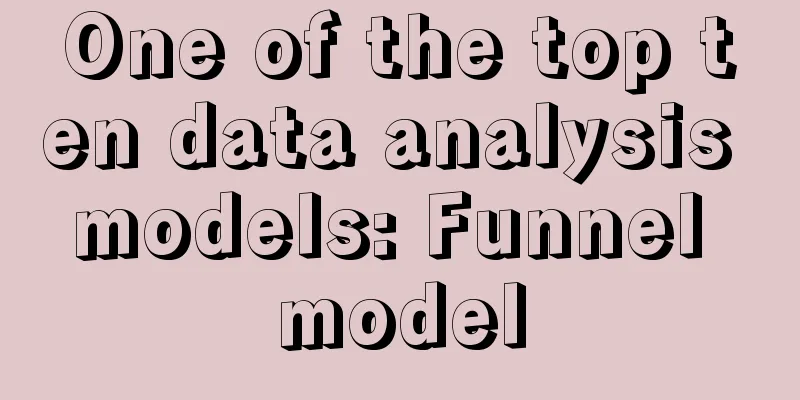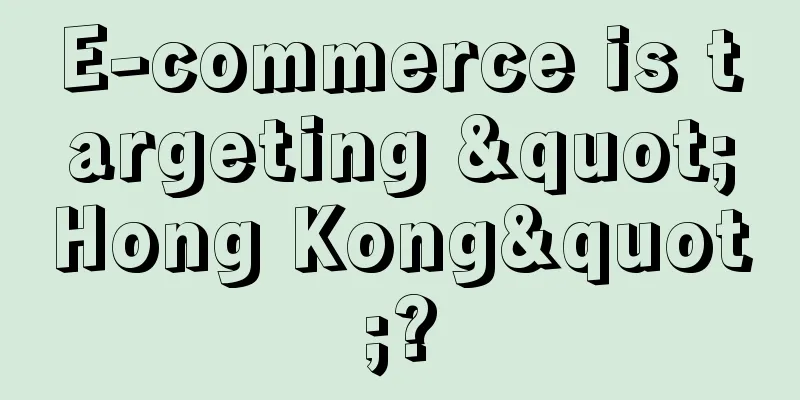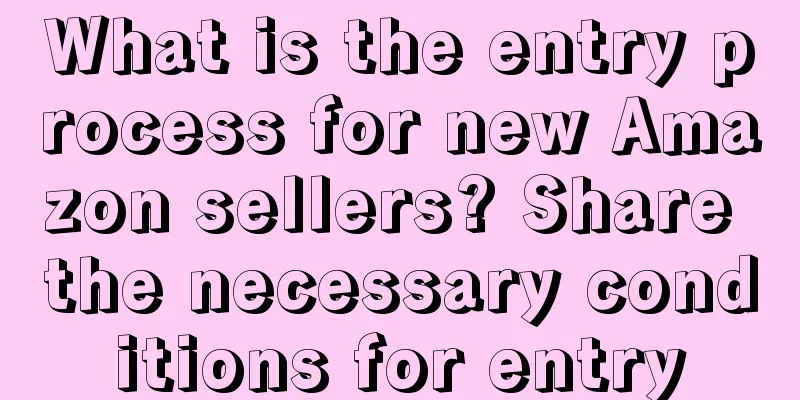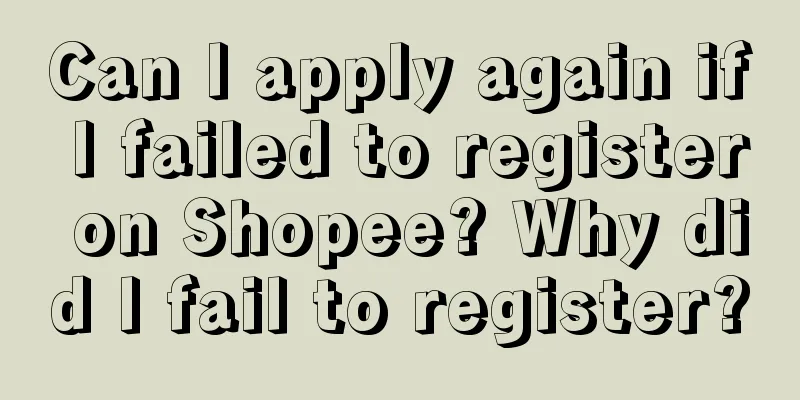One of the top ten data analysis models: Funnel model

Students often ask: "Can you systematically share what models are there in data analysis? Especially those commonly used in business?" In fact, there are 10 models commonly used in business. There are often some scattered sharing on the Internet. Today, Teacher Chen will start with the most common funnel model and systematically share its principles, operation skills and uses. Everyone, sit tight and hold on, the train will start immediately. 1. What is the funnel model?The funnel model should actually be called a "process-based business analysis model". It is a tool for analyzing and diagnosing the business based on business process data. Because in sales-side business, "the longer the process, the more users will be lost". For example, when shopping online, if you see a product you like, but click on it many times before you see the order page, the user will be lost. Therefore, as the number of steps increases, there will be user loss at each step, and the data is like a "funnel". Hence the name of the funnel model (as shown below). In fact, on the supply side, there is also a similar process analysis model, but instead of reducing the number of users at each step, it increases costs and output time at each step. For example, in a typical production process, raw materials, labor, and production costs are added to each step. For example, in the after-sales process, each step requires users to wait and consumes labor costs. The analysis method of these business processes is similar to that of the sales end, except that the focus has changed from churn to cost growth. If you like, you can call it the "rolling model" or the "flower roll model". This is what we often say: When looking at a data model, understand its essence, don't just memorize the name. 2. How to build a funnel modelConstructing a funnel model consists of three steps. Step 1: Clarify business background and business goalsIn layman's terms, it means locking the head and tail of the funnel. For example, in an online new customer promotion, the head of the process is usually an advertising page, but what about the tail of the process? Is it enough for the user to register? Or is it to consume one order after registration? Or is it to count the LTV within a certain period of time after registration? Different definitions of the head and tail of the process determine the length of the process and the assessment method, so it is necessary to clarify with the business department and the financial department first to avoid ambiguity. Step 2: Collect process data and construct a conversion funnelIn this step, we mainly follow the process and sort out the steps, record the process, time consumption and conversion rate of each step to the next step. Here are some common colloquial names, as shown in the figure below: Step 3: Collect business actions and understand factors affecting the funnelThis step is very important. It is useful for explaining why users do not convert and observing the results of business optimization processes. Why don't users click on our ad pages? Maybe it's because the ad material is not attractive enough. What kind of material will be attractive? Here we need to label the material selling points, style, etc. These are the factors that directly affect user conversion. Good labeling will facilitate analysis. Similarly, how long the promotion process is, how much information the user needs to fill in when registering, what the lead-in product is, and how much discount it is can all be labeled. This can be used to analyze which one is more effective in attracting users. This step is often forgotten, and the consequence of being forgotten is that you know the results but not the reasons, and you cannot make an in-depth analysis. With these three steps, a complete funnel is constructed and can be analyzed. 3. How to use the funnel modelPurpose 1: Explain business processes and analyze problemsThis is the most intuitive use of the funnel analysis method. People will see which process has the most loss before the user completes the transaction. Which link has the highest cost consumption before the product is produced. After seeing these problems, they will naturally think about how to improve them. This is the first and biggest use. Use 2: Optimize business initiatives and observe improvement effectsContinuing from the previous step, after discovering that a process has a low conversion rate, you can start to improve it. For example, if you find that the promotional ad page has very few clicks, you can consider modifying the ad page pictures and copywriting, at least to lure people in first, and then think about the conversion later. Every time you optimize the conversion funnel, remember to make a record to see clearly which step is optimized this time, whether the overall effect is improved after optimization + whether the step is improved, so as to judge whether the optimization measure is OK. (As shown below) In this step, it is important to distinguish between global and local influencing factors, which is the premise of analysis. For example, in the conversion funnel in the above example, brand, product, and price are global influencing factors. If it is the latest Huawei Mate 60, as long as it is in stock, the copywriting can be written casually. No matter how long the process is, users will hold their noses and stick to the end to buy, thus improving the conversion rate of the entire process. If it is just a poster on an ad page, it may only affect the user to click on the ad page, which is a local influencing factor. Distinguishing between the two is conducive to observing the actual effect of business improvements. Use 3: Compare multiple funnels and select the best solutionIf there are several processes pointing to the same goal, people will definitely tend to choose: large traffic and high conversion efficiency. When comparing and analyzing multiple funnels, we also give priority to the beginning and the end, that is, how large the traffic of the funnel is and how high the overall conversion rate of the funnel is. At this time, we can combine the matrix analysis method to analyze the advantages and disadvantages of the participating funnels (as shown in the figure below). There are two cases where a more in-depth analysis is required. First: Different funnels attract different types of users. For example, when promoting the same product, the sources of G-type customers and ordinary B-end customers are different, and only a certain channel can attract them. At this time, even if the conversion rate of this channel is worse, there is no way to give up. Second: The stability of the funnel performance is very important. People naturally trust channels with stable conversions more than roller coaster channels that have huge traffic one day and zero traffic the next. These are the three major uses of the funnel model, which completely covers the front, middle and back parts of the analysis. It is very useful. But some students may ask: Why is this thing so useful, I don’t usually see it? ? ? Because it also has its shortcomings. 4. Disadvantages of the Funnel ModelThe biggest drawback of the funnel model is that it requires too much data to be collected. This is why the funnel model is only used a lot in the Internet industry, because online behavioral data is easy to collect through embedding points. Offline data is difficult, so it is difficult for traditional industries to construct a conversion funnel. For example, typical B2B sales also have obvious conversion funnels, but it is too troublesome to expect salespeople to honestly report every customer communication message. This requires the coordination of a management system + CRM system + digital sales support tools. For example, in a typical retail store, in theory, users also have a conversion process of entrance → entering the store → moving line → staying → closing, but there is no way to record walking data. For example, in telephone sales, the rejection rate is too high, resulting in a large number of conversions being cut off at the first step. All these make it difficult for traditional industries to use the funnel model. Author: Down-to-earth Teacher Chen Source: WeChat public account: "Down-to-earth Teacher Chen (ID: gh_abf29df6ada8)" |
>>: The copywriting written by AI won an award!
Recommend
What is the Amazon Operations Tutorial? How to operate it?
As the Amazon platform continues to grow, more and...
What should I do if Amazon keeps asking for a verification code when logging in? Why can't I log in?
If you want to buy foreign products on Amazon, you...
Short drama CPS, 10 million views a day
The popularity of short dramas is growing, and the...
Share some basic marketing concepts and important marketing theories
Marketing seems simple but it is not simple at all...
Meituan Group Buying is available online for instant pick-up, and it is competing with Douyin and Kuaishou in the "in-store war"
The food delivery business of Douyin and Meituan h...
eBay Australia to reduce Orange Connex delivery fees
eBay Australia recently announced that before Janu...
Community libraries house the poetry and distant places of young people
Community libraries are the new favorite of young ...
With video accounts undergoing drastic changes, how many new strategies will be introduced in the future?
This article mainly provides in-depth insights int...
How to make a budget for Xiaohongshu spotlighting? |Practical version of spotlighting
On Xiaohongshu, a marketing platform with great po...
Can I get back the money frozen due to copyright infringement? How can I appeal?
The Wish platform takes copyright protection very ...
How does Shopify attract traffic? What are the channels?
If you want your Shopify independent station to ga...
Newcomer Temu is eyeing the industrial belt, and the old Amazon can't sit still either
Competition in the cross-border e-commerce industr...
Copy homework! Teach you how to build an operations analysis system step by step
The analysis of a single operational action is cer...
The secret to 5 successful startups is to use product thinking for marketing
What kind of marketing methodology does Du Guoying...
E-commerce image and product testing: What to do if the link has bad data?
What is e-commerce image and product testing? What...









